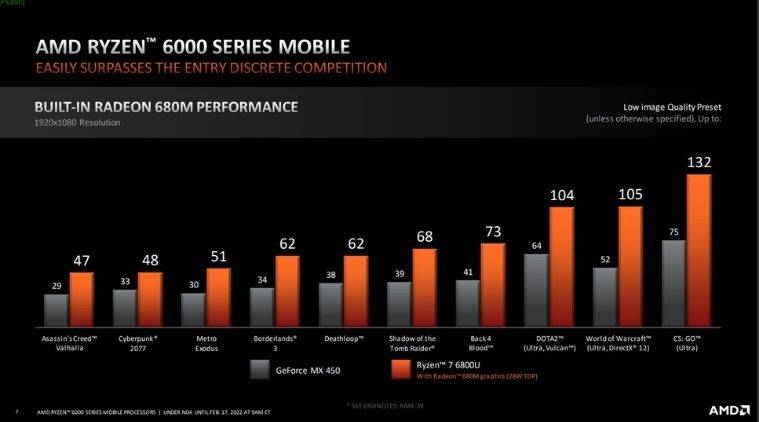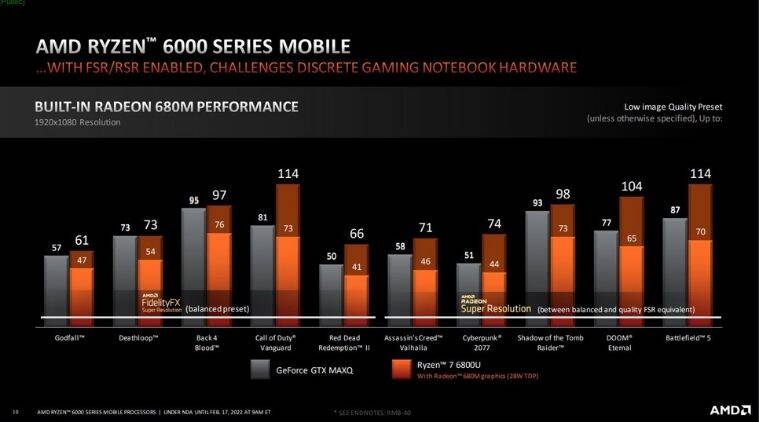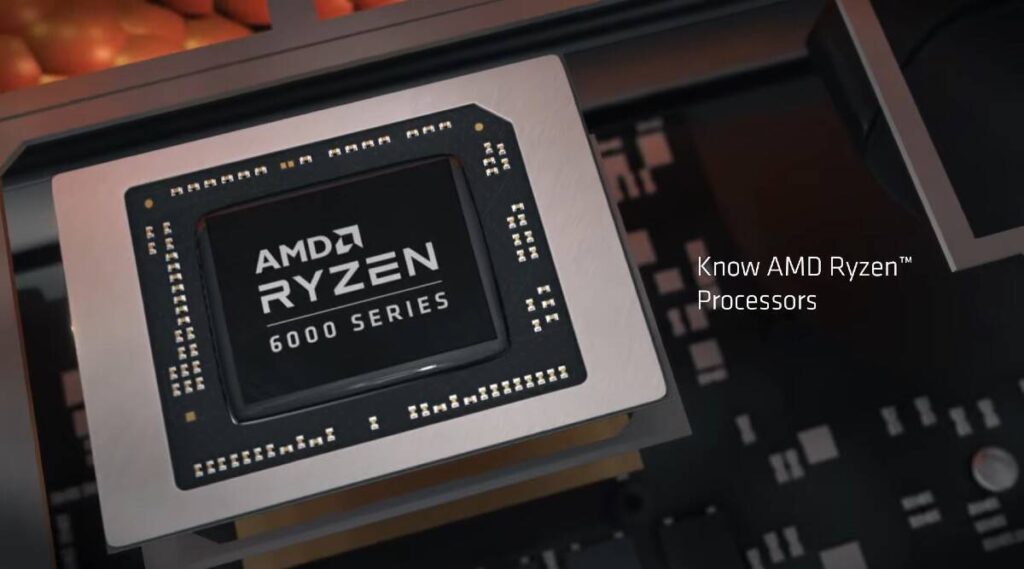Benchmark tests prove the Ryzen 6000 series mobile processors to offer uninterrupted 1080p gaming at low powers; matches framerates with laptops equipped with a discrete GPU.
Following its official announcement at CES 2022, AMD has now offered an in-depth look at their upcoming Ryzen 6000 series mobile processor. This year, the company plans to lead the laptop market with thinner, lighter, and more power-efficient designs.
Gaming Performance
Integrated GPUs are not powerful or ideal for 1080p gaming – borrowing some video memory for when there is no discrete graphics card. The new Radeon 600M integrated graphics, however, allows for 1080p gaming in most AAA titles, albeit there will be some low to medium graphic levels. AMD claims that their 680M graphics in the Ryzen 7 6800U is about 2 times faster than Intel’s Iris Xe. Benchmarks held against a GeForce MX 450 show an average of 48fps on demanding titles like Cyberpunk 2077 and reach an all-time high of 132fps on CS:GO.

AMD’s new Ryzen 6000 series processors allow for 1080p gaming at low settings – more fps on titles like Cyberpunk 2077 when compared to NVIDIA’s MX 450. (Image credit: AMD)
The Zen3+ architecture and AMD’s RDNA 2 already allow for power efficiency while maintaining low latency. But, with FSR (FidelityFX Super Resolution) and RSR (Radeon Super Resolution) enabled, the 680M processor manages to surpass framerates achievable by gaming laptops with discrete GPU – albeit on low image quality.

Most entry-level gamers are more concerned with being able to run a game smoothly, rather than worrying about how good the graphics look. So, these processors are ideal for them.
Coming to the Ryzen 5 6600U with Radeon 660M graphics, benchmarks show better overall performance than Intel’s Core i5-1135G7. When compared with a GeForce MX 450, these new discrete GPUs are able to match framerates to a degree, falling short by 4 to 5 fps on demanding titles like Battlefield 5. With FSR and RSR enabled, the numbers get even higher.

Players can expect super-fast clock speeds of up to 5GHz and PCIe 4.0 bandwidth for faster load times. The processors have already been laid out on some of the best laptops showcased at CES 2022, including the ASUS ROG Zephyrus G14, Razer Blade 14, the Zephyrus Duo, and Alienware M17 R5 to name just a few.
App Performance
The new Zen 3+ cores favour high performance while minimizing battery usage, boasting up to 24 hours of juice on normal use. It is the first chip to fully support Windows 11 security and is able to compensate multiple displays for content creators and streamers. As you would expect from a 2022 laptop, the processor comes with support for USB 4.0, DDR5 RAM, PCIe 4.0, and Wi-Fi 6E. Support for DisplayPort 2 is included as well, letting you connect an additional display with high refresh rates.
The market favours longer battery life and thinner form factors. As evidenced by the benchmark test above, the Ryzen 9 6900HS performs 2.62 times better than the 12th Gen Core i9. Not to mention, it only requires 35W of sustained CPU power limit to achieve those numbers, while running 8 cores on full load. For comparison, the Core i9-12900HK is a hexacore CPU.

At 15W of power, the Ryzen 6000 series is able to achieve 40 percent higher base clocks, with 1.17 times better CPU computing, 1.81 times better graphics, and up to 3 hours of generational battery life increase. Web browsing and other productivity tasks are faster, as you would expect. But, 3D GPU rendering easily takes the cake, offering a 3.05 times increased performance when compared to the last-gen Ryzen 7 5800U processor.
In March, AMD is looking to announce their HX Series of gaming laptops and the U series processors for ultrathin laptops. Between then and April, we could also expect to see a Pro lineup of machines, geared towards commercial and business enthusiasts.
Source: indianexpress.com


